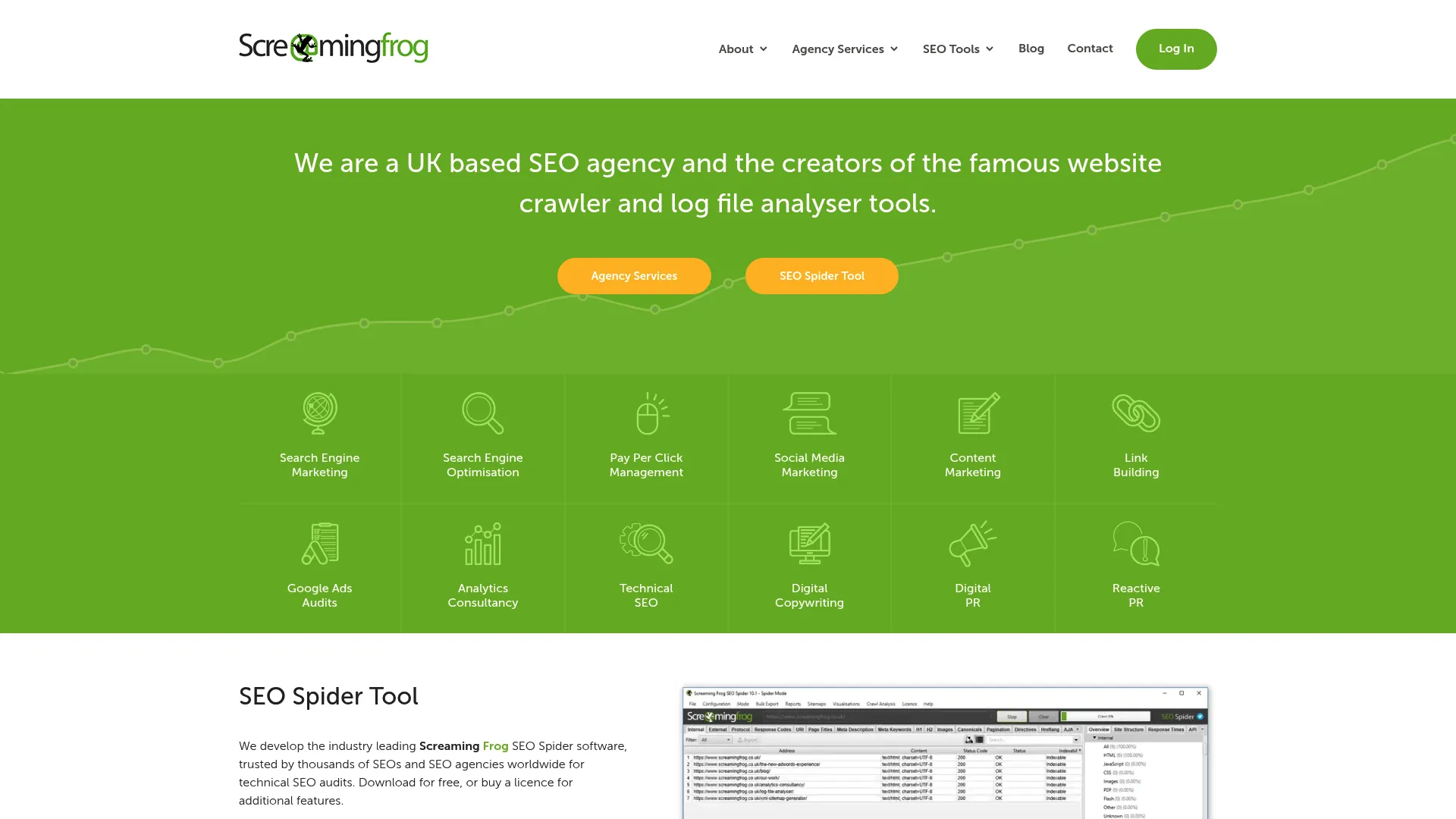
Screaming Frog SEO Spider: The Technical Audit Tool That Reveals Everything (But Fixes Nothing)
Last month, I was auditing a client’s e-commerce site at 2 AM (don’t ask why), and Screaming Frog found 847 broken product links that their previous agency had completely missed. That’s when it hit me—this ugly little desktop tool might look like it’s from 2005, but it’s still the best at what it does. After years of wrestling with this thing daily, I’ve figured out why this desktop tool remains the gold standard for technical SEO auditing—and why it might make you want to throw your laptop out the window before it saves your career.
Table of Contents
-
TL;DR: Key Takeaways
-
Screaming Frog SEO Spider
-
4 Alternatives to Screaming Frog
-
FAQ
-
Final Thoughts
TL;DR: Key Takeaways
-
Screaming Frog digs deep into technical SEO with crawling that sees your site exactly like Google does
-
The desktop interface looks like something a programmer built for other programmers (which is exactly what happened)
-
Handles huge websites without breaking and gives you unlimited crawling capacity
-
Strong connections with Google Analytics, Search Console, and other SEO tools actually make your life easier
-
At $279 annually with a functional free version, it’s worth every penny once you stop cursing at it
-
Finds every problem on your site but won’t tell you how to fix them—that’s the frustrating part
-
The community support is solid, though you’ll need patience to learn this beast
Screaming Frog Evaluation Criteria
|
Criteria |
Score |
Description |
|---|---|---|
|
Technical SEO Capabilities |
5/5 |
Finds absolutely everything wrong with your site—broken links, redirects, duplicates, you name it. Never lies about what it discovers |
|
Ease of Use |
2/5 |
Looks like it was designed in 2005 and feels even older. You’ll want to quit in your first week, guaranteed |
|
Scalability |
5/5 |
I’ve thrown 500,000-page sites at this thing just to see if it would break. Spoiler: it didn’t. My laptop fan sounded like a jet engine though |
|
Integration Options |
4/5 |
Plays nice with Google Analytics, Search Console, and most tools you actually use. Recent AI stuff is pretty cool too |
|
Advanced Features |
5/5 |
JavaScript rendering, custom data extraction, fancy charts—it’s got everything except the ability to make coffee |
|
Pricing Structure |
4/5 |
$279 sounds like a lot until you realize it just saved you 40 hours of manual work. Then it feels like highway robbery in your favor |
|
Support and Community |
3/5 |
They’ll help you if you pay them, but good luck if you’re on the free version. Reddit community is your real lifeline |
Screaming Frog SEO Spider
What Screaming Frog is Best Known For
Here’s the thing—Screaming Frog built its reputation by being that reliable friend who always tells you when you have spinach in your teeth. Since 2010, this desktop crawler has become the tool that every serious SEO keeps installed, even if they complain about it constantly. It’s like that old truck that looks terrible but never breaks down.
The tool’s superpower is seeing your site exactly like Google does. When you run a screaming frog crawl, you’re basically getting Google’s perspective without the corporate PR spin. This precision is why thousands of SEO professionals worldwide put up with its quirks—because when it finds something, you know it’s real.
What makes Screaming Frog different isn’t just that it crawls websites—lots of tools do that. It’s the obsessive level of detail it provides. I remember one client who swore their site was “perfectly optimized.” Twenty minutes into a Screaming Frog crawl, I found 1,200+ pages with duplicate title tags. The awkward silence on that Zoom call was… memorable.

Features
The real-time crawling is actually pretty satisfying to watch. You’ll see broken links, server errors, and redirect issues pop up as your site gets analyzed. There’s something oddly mesmerizing about watching thousands of URLs get processed—like a very nerdy screensaver that actually does useful work.
Custom extraction is where things get interesting. Using XPath, CSS selectors, or regex, you can scrape virtually anything from your pages. I’ve used it to extract product prices, social media share counts, and even check if specific tracking codes are installed. It’s like having a Swiss Army knife for data extraction.
JavaScript rendering through Chromium ensures you see dynamic content exactly as search engines do. Here’s a fun story—I once spent three hours manually checking a React-based site, convinced everything looked fine. Then I ran Screaming Frog with JavaScript rendering turned off and discovered that Google was seeing basically empty pages. Lesson learned: never trust what you see in the browser.
The recent AI integrations with OpenAI, Google Gemini, and Anthropic Claude add some modern flair to this old-school tool. These features are still pretty new, so most people haven’t figured out how to use them yet, but they show the tool is evolving with the times.
The visualization tools create these spider web-looking diagrams of your site that make you feel like you’re in some CSI: SEO episode. “Enhance… enhance… there’s the broken link!” Jokes aside, these visual representations often reveal structural problems that raw data might hide.
Pros
Finds Absolutely Everything
Screaming Frog’s ability to discover every technical SEO issue is both a blessing and a curse. From hreflang setup problems to canonical tag issues, nothing escapes its analysis. I’ve discovered problems with this tool that I completely missed during manual audits—and sometimes wished I hadn’t found them because now I had to fix them.
Handles Huge Websites Without Breaking
With a paid license, there are no restrictions on crawl size. Whether you’re auditing a 50-page local business site or a million-page e-commerce monster, Screaming Frog handles it efficiently. The unlimited crawling thing is actually pretty sweet—I’ve thrown massive sites at this thing just to see what would happen.
Sees Your Site Like Google Does
The Googlebot simulation is scary accurate, which gives you confidence that the problems you find actually matter for search rankings. You’re not chasing phantom issues that don’t affect real crawling behavior—every problem it finds is something Google would stumble over too.
Plays Nice with Other Tools
API connections with Google Analytics, Search Console, PageSpeed Insights, and third-party tools create a comprehensive analysis environment. These integrations transform raw crawl data into actually useful insights by combining multiple data sources instead of making you juggle twelve different spreadsheets.
Never Goes Down
No cloud dependencies mean no “sorry, our servers are down” messages when you’re on deadline. The tool runs entirely on your machine, ensuring it’s always available when you need it. I can’t count how many times I’ve been grateful for this reliability during tight project deadlines while other tools were having “maintenance windows.”
Cons
The Learning Curve From Hell
Look, I’m going to be honest here—the first time I opened Screaming Frog, I wanted to throw my laptop out the window. The interface looks like something a programmer built for other programmers (which, let’s face it, is exactly what happened). New users often feel overwhelmed by the interface and extensive feature set, and getting good at this tool requires significant time investment.
Looks Like It’s From 2005
The desktop application feels ancient compared to modern web-based tools. Navigation can be clunky, especially if you’re used to sleek SaaS interfaces. The UI hasn’t evolved much since the early 2010s, and boy, does it show. It’s functional, but pretty it is not.
Won’t Hold Your Hand
Here’s what drives me crazy about Screaming Frog—it finds everything wrong with your site but doesn’t tell you what to fix first. You’ll run your first audit, and BAM—3,000 “issues” appear on your screen. Half of them you don’t understand, and the other half seem contradictory. Don’t expect it to prioritize or give you a step-by-step action plan.
Technical Stuff Requires Technical People
Many powerful features require you to actually know what you’re doing to use them effectively. Casual users struggle to leverage the tool’s full capabilities without diving deep into technical documentation that reads like it was written by robots for robots.
No Team Collaboration
The desktop-only nature makes team collaboration a pain. Want to share results? You’re manually exporting and emailing files like it’s 1999. This becomes especially problematic for agencies working with multiple team members on the same project.
Criteria Evaluation
Technical SEO Capabilities: 5/5
Screaming frog delivers comprehensive crawling that sees your site exactly like search engines do. It detects broken links, analyzes redirects, identifies duplicate content, audits meta tags, and handles complex technical issues with exceptional precision. I’ve never encountered a technical SEO problem that this tool couldn’t identify and analyze thoroughly—sometimes too thoroughly.
Ease of Use: 2/5
This is where the tool falls flat on its face. The desktop interface feels outdated and overwhelming for beginners, requiring significant technical knowledge to get any value from it. The learning curve is steep and can be frustrating for newcomers who expect modern, intuitive interfaces that actually help you understand what you’re looking at.
Scalability: 5/5
Outstanding performance across all website sizes. The hybrid storage engine efficiently handles millions of URLs, and unlimited crawling capacity makes it suitable for enterprise-level projects without your computer catching fire. I’ve crawled sites with over 500,000 pages without any significant slowdowns—though my laptop fan definitely noticed.
Integration Options: 4/5
Strong API integrations with Google Analytics, Search Console, PageSpeed Insights, and third-party tools actually make your workflow smoother. Recent AI integrations with OpenAI and Google Gemini add modern functionality, though these features are still pretty new and most people haven’t figured them out yet.
Advanced Features: 5/5
Impressive feature set including JavaScript rendering, custom data extraction, semantic similarity analysis, visualization tools, and crawl comparison functionality. Regular updates keep the tool current with evolving SEO trends and requirements. The depth of available features continues to surprise me even after years of daily use.
Pricing Structure: 4/5
Competitive pricing at $279 annually with a functional free version for up to 500 URLs. Volume discounts make it accessible for agencies and teams, though that free version limitation is basically a cruel joke if you work with real websites.
Support and Community: 3/5
Responsive support for paid users within 24 hours, but if you’re on the free version, you’re basically on your own. Strong community presence exists on Reddit and forums, though the official documentation could be way more beginner-friendly for people who don’t speak fluent nerd.
Community Reviews and Expert Recommendations
The SEO community consistently rates screaming frog highly across review platforms, with most ratings hovering around 4.5/5 stars. The Reddit SEO community treats Screaming Frog like that reliable old truck that looks terrible but never breaks down. Everyone’s got a horror story about the learning curve, but nobody’s switching to anything else. That should tell you something.
Reddit discussions reveal that experienced practitioners love the tool’s flexibility and comprehensive analysis capabilities. However, beginners frequently struggle with the lack of guidance and recommendations that other tools provide (source: reddit.com/r/SEO). The community often recommends investing significant time in tutorials before expecting productive results—and they’re not kidding about the time investment.
Technical considerations occasionally surface in user feedback. Websites with security measures, firewalls, or Cloudflare protection may require additional configuration steps for optimal crawling performance (source: reddit.com/r/TechSEO). These challenges highlight the tool’s technical nature and the expertise required for complex implementations.
Performance feedback indicates that sites exceeding 250,000 pages may benefit from alternative solutions or additional server resources. Users note the tool performs best on server-grade hardware rather than basic laptops for comprehensive audits (source: reddit.com/r/bigseo). The tool maintains strong ratings across platforms with an average of 4.5/5 stars, with users consistently praising its crawling capabilities and technical accuracy while noting the challenging learning curve.
Price
The screaming frog pricing structure balances accessibility with functionality, though that balance might feel a bit wobbly at first. The free version handles up to 500 URLs, which works for tiny sites but quickly becomes limiting for any real audit work. This limitation often forces users to upgrade sooner than they’d prefer—which I’m sure is totally accidental.
At $279 annually for unlimited crawling, the paid license offers excellent value considering what you get. $279 sounds like a lot until you realize you just saved 40 hours of manual checking on one audit. Then it feels like highway robbery—in your favor. Volume discounts make it even more attractive for agencies:
• 5-9 licenses: $265 each
• 10-19 licenses: $249 each
• 20+ licenses: $235 each
The company has implemented only two price increases over 15 years, which is refreshing in an industry where many tools seem to raise prices every time someone sneezes. This consistency is something agencies and consultants can actually rely on for budget planning.
Where to Find Screaming Frog
Download screaming frog directly from screamingfrog.co.uk for Windows, macOS, and Linux systems. The download process is straightforward, and installation typically takes just a few minutes. No complicated setup procedures or lengthy configuration processes—just download, install, and start questioning your life choices as you stare at the interface for the first time.
4 Alternatives to Screaming Frog
Sitebulb
This is what Screaming Frog would look like if it went to design school and actually cared about user experience. Sitebulb offers both desktop and cloud versions with a user-friendly approach to technical SEO crawling. The tool provides intuitive “Hints” that explain technical issues in plain English instead of throwing technical jargon at you and expecting you to figure it out. My junior team members love it because it doesn’t make them feel stupid. Pricing starts at $135/year for desktop and $2,940/year for cloud versions. Visit Sitebulb
Lumar (formerly DeepCrawl)
An enterprise-focused cloud-based crawler designed for large-scale technical SEO auditing. Lumar excels at handling massive websites and provides advanced reporting features that actually look professional when you’re presenting to clients. It’s particularly strong for enterprise teams needing collaborative workflows and detailed technical analysis. The platform focuses heavily on data visualization and team collaboration features that Screaming Frog completely ignores. Visit Lumar
OnCrawl
A cloud-based technical SEO platform that combines crawling with log file analysis—which is pretty clever when you think about it. OnCrawl offers strong visualization capabilities and focuses on data-driven insights. It’s particularly valuable for understanding how search engines actually interact with your website through server logs. This dual approach of crawling and log analysis provides unique insights into search engine behavior that you can’t get anywhere else. Visit OnCrawl
Search Atlas
Okay, this one’s interesting because it doesn’t just find problems—it actually fixes them. Revolutionary concept, right? Search Atlas stands out as the best screaming frog alternative because it offers precise technical auditing and crawling with automated fixes and recommendations. Unlike Screaming Frog, which only identifies issues, Search Atlas actually fixes SEO problems automatically. The platform includes comprehensive site audits, interactive visualization, real-time monitoring, and one-click technical fixes. It’s like having a mechanic who doesn’t just tell you your car is broken but actually fixes it too. This automation addresses the biggest gap in Screaming Frog’s functionality—the lack of actionable solutions. Visit Search Atlas
FAQ
What makes Screaming Frog different from other SEO crawlers?
Screaming frog’s desktop setup eliminates cloud dependencies and crawling limitations that plague many competitors. You get unlimited crawling capacity with a paid license, something that’s pretty rare in the SEO tool world. This independence from cloud infrastructure means consistent performance regardless of whether your internet is having a bad day.
The accuracy of how it mimics Google is exceptional. While other tools kind of approximate search engine behavior, Screaming Frog replicates it with scary precision, giving you confidence that the problems you find actually matter. This accuracy becomes crucial when you’re making technical recommendations to clients who are paying you to know what you’re talking about.
Raw data presentation without sugar-coating appeals to experienced practitioners who want flexibility in analysis. You’re not locked into someone else’s interpretation of what constitutes a “critical” issue—you get to decide what matters based on your expertise and the specific situation.
For additional context on technical SEO implementation, our comprehensive SEO content tools review explores how various tools complement each other in a complete technical audit strategy.
Is Screaming Frog suitable for beginners?
Honestly? It’s like handing someone a Formula 1 car when they just got their learner’s permit. Sure, they can technically drive it, but they’re probably going to crash into a wall first. The screaming frog interface assumes you already know what you’re looking at, and the learning curve is steep without proper guidance.
The free version allows you to mess around with up to 500 URLs, which helps beginners understand what the tool can do. However, interpreting results and prioritizing fixes requires SEO experience that beginners typically lack. You might identify hundreds of issues without knowing which ones actually matter for your rankings versus which ones are just noise.
The first month I used this tool, I printed out the reports. Yes, printed them. 847 pages of technical data that I thought I needed to review line by line. My colleagues still make fun of me for this. Don’t be me—learn the filters first, and start with something friendlier like Sitebulb before diving into this beast.
How does Screaming Frog handle JavaScript-heavy websites?
The screaming frog JavaScript rendering capability uses Chromium to process dynamic content, ensuring you see pages as search engines do. This feature has become crucial as websites increasingly rely on JavaScript for content delivery. Modern sites built with React, Angular, or Vue.js need this functionality to reveal their true content structure—otherwise you’re basically auditing empty pages.
Configuration matters for getting good results. JavaScript-heavy sites sometimes need adjustments like user agent modifications or private browsing sessions to crawl effectively. You might need to tweak timeout settings or enable specific rendering options depending on how the site loads content. Pro tip I learned the hard way: Don’t run a full JavaScript crawl on a million-page site during a client call. Your computer will sound like a jet engine, and you’ll look like an amateur.
Performance can slow down significantly when JavaScript rendering is enabled, especially on larger sites. You’ll want to balance thoroughness with crawling speed based on your specific needs and how much time you have before your laptop overheats. The tool handles JavaScript-heavy websites through Chromium-based rendering that processes dynamic content as search engines do, though it requires proper configuration and patience.
Final Thoughts
Look, after using this thing daily for years, here’s the truth: Screaming Frog is like that friend who always tells you when you have spinach in your teeth. Annoying? Sometimes. Necessary? Absolutely. Will it make you a better SEO? Without question.
The tool’s greatest strength—comprehensive technical data without interpretation—is also its biggest weakness for newcomers. You get raw insights that require expertise to translate into actionable strategies. Here’s what’s weird about Screaming Frog—I simultaneously love and hate it. Love it because it’s never lied to me about what’s broken on a site. Hate it because sometimes I wish it would just… lie a little? Like, maybe don’t show me ALL 500 missing alt tags at once?
For agencies and experienced practitioners, the $279 annual investment pays for itself quickly through time savings and audit accuracy. I had a client once who insisted their site was “lightning fast.” Screaming Frog found images that were 15MB each. Fifteen. Megabytes. For a product photo. The awkward conversation about why their mobile users were crying wasn’t fun, but at least we fixed it.
However, if you’re just starting in technical SEO or need collaborative features, consider alternatives that offer more guidance and modern interfaces. Tools like Sitebulb or Search Atlas provide the hand-holding that Screaming Frog deliberately avoids—and there’s no shame in needing that guidance when you’re learning.
Just don’t expect it to be pretty about it. The tool remains the gold standard for technical SEO auditing despite looking like it was designed by engineers who think user experience is a suggestion rather than a requirement. The question isn’t whether you need it—it’s whether you’re ready to invest the time to master it and stop cursing at your screen every time you open it.





